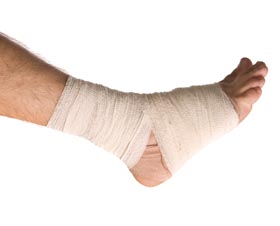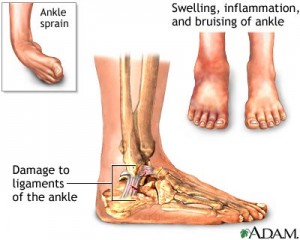 We have all twisted an ankle or pulled a muscle at some time. But many of us are not sure what to do when this happens. This article discusses these basic types of injury and information regarding injury first aid and rehabilitation.
We have all twisted an ankle or pulled a muscle at some time. But many of us are not sure what to do when this happens. This article discusses these basic types of injury and information regarding injury first aid and rehabilitation.
In fencing, sprains and strains are the most common injuries. According to a published study on fencing injuries, “approximately one half of all injuries to fencers occur in the lower extremities, with the ankle and the knee being the predominant sites”. Given the asymmetrical nature of the sport and the quick changes of direction required, ankle sprains are not an uncommon injury.
Sprains
A sprain is an injury to a joint ligament. Ligaments are the strong bands of tissue that connect one bone to another at a joint. The severity of the injury can be classified by the amount of tissue tearing, joint stability, pain and swelling.
Types of Sprains
The mildest sprain (first degree) has little tearing, pain or swelling, and joint stability is good. The second degree sprain has the broadest range of damage, with moderate instability, and moderate to severe pain and swelling. The most serious sprain is a third degree sprain. The ligament is completely ruptured and the joint is unstable. There may be severe pain at first, but afterward there may be no pain. There will be a lot of swelling with this type of sprain, and often other tissues are damaged.
Strains
A strain is damage to muscle fibers and to the other fibers that attach the muscle to the bone. Other names for a strain include “torn muscle,” “muscle pulls” and “ruptured tendon.”
Muscle injuries are classified from first (least severe) to third (most severe) degree strains. A first degree strain has little tissue tearing, mild tenderness and pain with full range of motion. As with the sprains, the second-degree strain has a wide variability. Muscle or tendon tissues have been torn, resulting in very painful, limited motion. There may be some observable swelling or a depression at the spot of the injury with a second degree strain. The third-degree strain involves complete rupture of a part of the muscle unit. Motion will be severely decreased or absent. Pain will be severe at first, but the muscle may be painless after the initial injury.
Acute Treatment
There are several decisions that you must make when you injure yourself. Among the first of these is how serious the injury is and whether you should go to a healthcare provider. Look for deformities, significant swelling and changes in skin color. If there are deformities, significant swelling or pain you should immobilize the area and seek medical help. Many fractures will not cause a deformity, thus is there is any doubt or concern you should get medical attention.
P + R.I.C.E.
Stage One
Management of both sprains and strains follows the “PRICE” principle.
P – Protect from further injury
R – Restrict activity
I – Apply Ice
C – Apply Compression
E – Elevate the injured area
This principle limits the amount of swelling at the injury and improves the healing process. Splints, pads and crutches will protect a joint or muscle from further injury when appropriately used (usually for more severe sprains or strains).
Activity restriction (usually for 48-72 hours) will allow the healing process to begin. During the activity restriction, gentle movement of the muscle or joint should be started.
Ice should be applied for 15 to 20 minutes every hour to hour and a half.
Compression, such as an elastic bandage, should be kept on between icing; you may want to remove the bandage while sleeping, though keeping it compressed even during the night is best.
Elevating the limb will also keep the swelling to a minimum. Acute treatment is the first stage of rehabilitation.
| IMPORTANT: If you suspect more than a mild injury, cannot put weight on the limb, or it gives way, you should consult with a healthcare provider. |
Rehabilitation
Following the first 48 to 72 hours, it is important to start the next stage of rehabilitation.
The second stage of rehabilitation focuses on gentle movement of the muscle or joint, mild resistive exercise, joint position training and continued icing. When you are able to move without pain you can progress to the next stage of rehabilitation.
Use pain as your guide
During this stage you may gradually return to more strenuous activities, such as strengthening. A simple guide to how much you can do is pain. Pain should remain low during rehabilitation; if pain increases it usually means you have attempted to do too much.
Throughout your recovery you can still maintain an aerobic training program. Options for training include stationary bicycling, swimming, walking or running in the water. If the injury is more than mild sprain or strain it is best to consult your healthcare provider.
Example: Ankle Rehabilitation
Stage Two (after initial 48-72 hours swelling has stopped increasing and pain decreases)
Range of Motion
- Towel pull with toes
- Draw the alphabet with ankle
Mild Resistive Exercises
- Foot press—up, down and each side, against a solid object (no motion of the ankle)
- Tubing exercises in all motions (pain free)
Joint Position
- Standing with eyes closed—partial squats and shifts from side to side
Stage Three (pain free; can walk without limp)
Range of Motion
- Stretching with Towel
Strengthening
- Toe Raises
- Hops—start forward and back, short hops
- Weights—Heavy tubing or cuff weights
Joint Position
- One-legged stand with eyes closed
Written by A. Lynn Millar, Ph. D., PT, FACSM and approved by the American College of Sports Medicine (ACSM).
More details on ankle sprains published by the ACSM are available here.
Reprinted with permission of the American College of Sports Medicine. Copyright © 2005



2 Comments
Comments are closed.